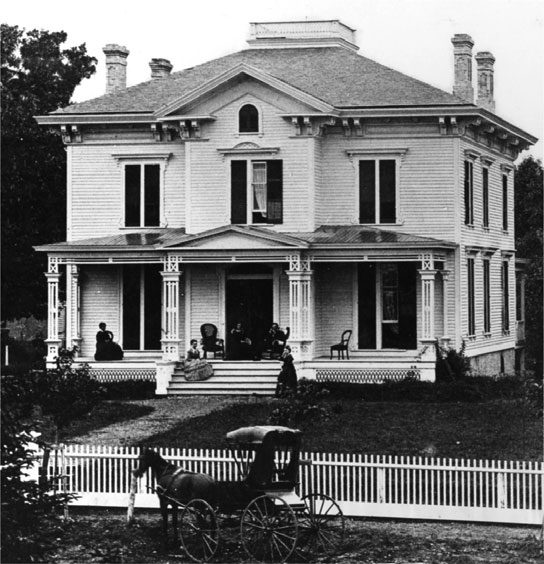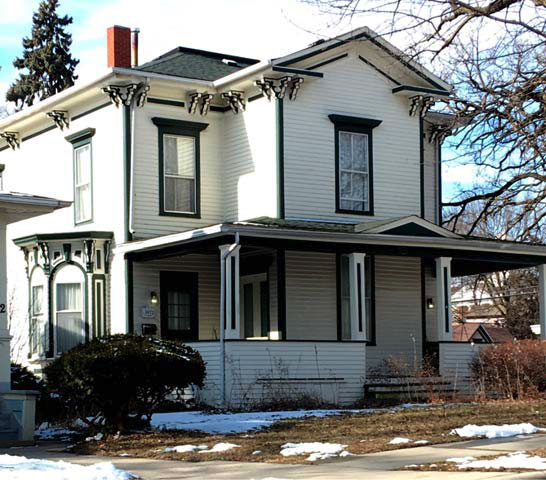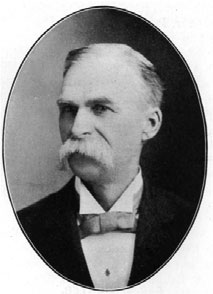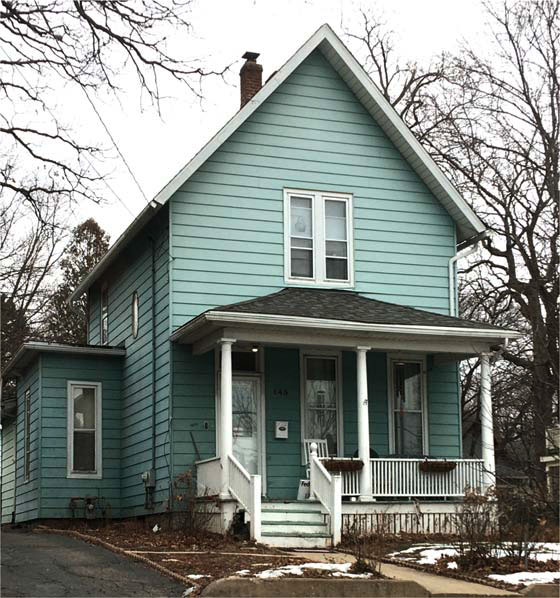By David Siegenthaler

In 1866-67, William G. Hubbard’s second Elgin home, a large Italianate, was built at 378 Division St. In November 1873 this home was sold to Emeline Borden, second wife of Gail Borden. Intending to move here, Gail Borden became critically ill in Texas and died there on January 11, 1874. Emeline Borden and her son Alfred Church moved into the home and Emeline lived there until her death in 1890. Alfred built the home next door at 364 Division St. in 1886- 87. The Hubbard/Borden home at 378 Division St. still stands but was extensively remodeled in 1919 and converted into a Christian Science church with a Greek Revival style. It has been home to several different congregations since then.

In 1873, before he sold his home to the Bordens, William built his third Elgin home, an Italian-style villa, at 140 N. Gifford St. William and his wife Charlotte remained in this home until their deaths in the 1880s, and then their son Will and his wife Callie lived there until 1915. In 1920 the home was sold to Matilda Lange, whose husband Henry converted the home into several apartments. The home remained a multi-unit apartment house until 2001, when it was deconverted to a single-family home again. William died of pneumonia December 15, 1883, at age 79. His wife Charlotte died March 10, 1885, at age 68. They are buried in Bluff City Cemetery.
Henry Wright Hubbard, son of William G. and Charlotte, was born May 17, 1844, in Elgin. Like his father, he was active in the abolitionist cause and the First Congregational Church, to whom he bequeathed $5,000. Henry was educated at Elgin Academy and the University of Michigan law school. He served in the Civil War, then returned to Elgin, where he practiced law and helped organize the YMCA. He also practiced law at Denver, Colorado, and taught mathematics for a few years at Fisk University, a school for newly-freed slaves in Nashville, Tennessee.
In about 1879 Henry began a 34-year career as treasurer of the American Missionary Association in New York City. He died of heart failure on May 21, 1913, in a bank vault in New York City and is buried in Bluff City Cemetery. He was a wealthy man and bequeathed the bulk of his estate to the American Missionary Association for work among African-Americans of the South.
According to Elgin historian Mike Alft, Henry was the first person born in Elgin to be listed in the prestigious “Who’s Who in America.” He was a bachelor who considered Elgin as his ultimate home and was a frequent visitor to friends and relatives here.
William (“Will”) Hubbard, the last-born child of William G. and Charlotte, was born June 27, 1849, in Elgin. He was educated at Elgin Academy, Beloit College and the University of Illinois, where he was a member of the first graduating class in 1872. At age 20 he became a telegrapher for the Union Pacific railroad and worked at Greeley, Colorado. On July 10, 1872, Will married Callie Edwards of Champaign, Illinois. Callie was born November 14, 1852, in Felicity, Ohio, and her family moved to Champaign when she was a child.
Will and Callie’s first three children died young. Winifred (1875-76) and William (1877; 3 days old) died in Champaign. Charlotte (1879-83) died in Elgin. Their other two children were Ethel (1886-1977; Mrs. Roy Webster) and Marguerite (1891-1981; Mrs. Lyman Weld). Will and Callie moved to Elgin about 1879 and lived at 128 N. Gifford St. When Will’s mother died in 1885, they acquired her home next door at 140 N. Gifford St., and lived there until 1915, when they moved to their new home at 722 Cedar Ave. About 1923, the couple moved to Winnetka to live with their daughter and son-in-law, Marguerite and Lyman Weld. Callie died there June 29, 1925, at age 72, and Will died May 22, 1930, at age 80. They are buried in Bluff City Cemetery.
Fascinated by telegraphy and telephony since his teen years, Will experimented with many different systems, inventing early versions of the telephone, both electrical and mechanical. Eventually, Alexander Graham Bell’s invention won out. Telephone exchange franchises operating under Bell’s patents were being granted throughout the country. Will obtained the Chicago Telephone Co. franchise for Elgin in 1881 and supervised installation of the equipment on the second floor of his father’s building. He solicited subscriptions and managed the exchange for seven years. In 1888 he left to devote his energy to the development of independent telephone interests. That year Will and three partners incorporated the Elgin Telephone and Electric Supply Co. By the turn of the century, however, Will had changed careers and become an insurance agent.
Will’s private collection of antique telephone and telegraph instruments was shown throughout the country. He was the only independent exhibitor of “electric telephones” at the World’s Fairs in Chicago (1893) and St. Louis (1904), and his exhibit depicting the evolution of the telephone was purchased by Purdue University. At the time of his death he was collecting a display of antique telephone and telegraph instruments for Chicago’s Rosenwald Industrial Museum, now the Museum of Science and Industry.

Augustine (“Gus”) Hamilton Hubbard, no relation to the William G. Hubbard family of Elgin, was born March 17, 1843, in Salem, Michigan, to Harvey and Emily Hamilton Hubbard. In 1855 he moved with his family to Minnesota, where he graduated from the state normal school at Winona and worked as a store clerk in Lake City. In 1861 he went to St. Paul to enlist in the Union Army but was persuaded by General Sibley to be his special messenger, carrying messages between the military posts of the Northwest during a period of Indian uprisings. For three years he was engaged in this service, almost day and night in the saddle, facing every kind of danger.
In 1864 Gus came to Chicago, where he graduated from Eastman’s Business College. He then became a dairy farmer in McHenry County for three years, where he married Martha Lorette Hatch on October 25, 1870. Martha was born April 14, 1850, in McHenry County. In March 1871 the couple moved to Elgin where Gus partnered with R.W. Padelford in the insurance business. In 1876 he partnered with Erastus Gilbert in an insurance firm that also dealt in real estate and loaned money. In 1877 he was elected justice of the peace, an office which he held for the next 26 years.
Gus and Martha had two children: Frederick A. (circa 1872-1956) and Lewis Roy (“Roy,” circa 1876-1935). Frederick married Beryl Burns in 1895 and they had a daughter Dorothy. He became an insurance executive and in 1914-15 built a new home at 950 W. Highland Ave. In September 1915, as they were preparing to move to New York City for Frederick’s job promotion, Beryl died. Frederick became president of multiple insurance companies and lived in New York and Florida, where he died in Fort Myers. His widow, Luella, died in 1989. Roy married Clara Mackey in 1897 and both died in Chicago—Roy in 1935 and Clara in 1948. Gus’ wife Martha died February 11, 1897 and he married Clara Pettis June 1, 1898.

In 1903 Gus was elected mayor of Elgin and served a 2-year term. He defeated Arwin Price, who had been mayor for the three preceding terms (1897-1903). Gus’ administration was highlighted by a large increase in the miles of paved streets, a requirement for concrete sidewalks, and a revision of the building ordinance, focusing on fire safety, following the horrific Iroquois Theater fire in Chicago.
Gus lived at 145 Hill Ave., a home he owned and occupied from 1883 until his death in 1926. In 1890, when George E. Linkfield’s Addition was platted in northwest Elgin, it included Hubbard Ave., a street named for him. In 1926, when Green Acres Subdivision was platted, Hubbard Ave. was extended north to Wing St. Gus died June 3, 1926, and is buried in Bluff City Cemetery. His widow Clara died October 26, 1935.
Acknowledgments: Mike Alft’s books and newspaper articles; Kane County histories; “Elgin Today” (1903); obituaries and other newspaper articles; Internet sources; city directories; federal censuses; Kane County Recorder of Deeds research by Laurel Garza; house photos by Judy Van Dusen; etc.
